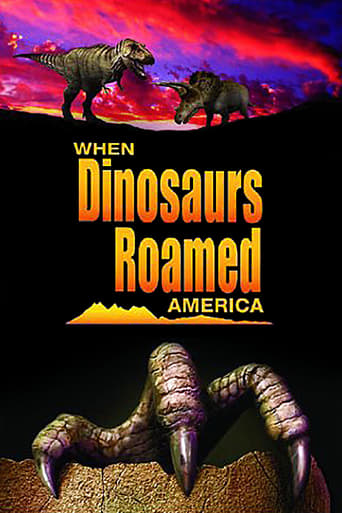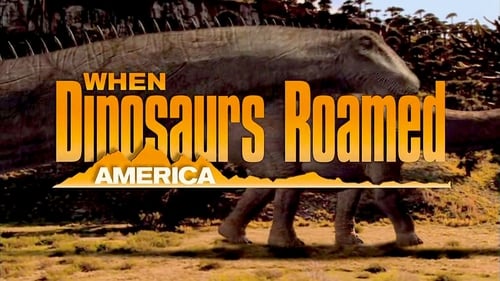John Panagopoulos
Even among admirers of "When Dinosaurs Roamed America" (hereafter WDRA), there is a reluctant admission that this BBC-production prehistoric animal follow-up is not quite up to the lofty standard of its predecessor, the destined-to-be-a-classic "Walking with Dinosaurs". Some disapprove of the somewhat less-than-convincing CGI of animal movements and interactions. Others disapprove of narrator John Goodman's somewhat irreverent and less-authoritative tone. Still others may get antsy with the interspersed interruptions of paleontologists talking about the fossils and bones that inspired the CGI recreations. I concede that these fault findings are not without some validity.However, I was still impressed with the somewhat second-tier WDRA. WDRA at least matches the "Walking..." series with the broad scope of its analysis of prehistoric creatures and its resistance to "getting on with it" and showing us the dinosaurs already. WDRA is chronologically episodic like "Walking..." but the episodes segue and blend into each other better, even when they use the paleontologists as transition. Each episode displays a part of Modern America (New York, Pennsylvania, Utah, Colorado, South Dakota), then dissolves into a prehistoric past that shows the environment and creatures at the time. WDRA begins with the Permian period and ends with the Cretaceous period. We work our way from non-dinosaurs like the crocodile-like Rutiodon and Desmatosuchus, through early dinosaurs like Coelophysis, Anchisaurus, Syntarsus, and Dilophosaurus, through feathered raptors like Velociraptor and ceratopsian ancestors like Zuniceratops, to the freakish therizinosaur Nothronykus, to finally the dinosaurs we know and love (Stegosaurus, Ceratosaurus, Allosaurus, Camarasaurus, Apatosaurus, Triceratops, and the ubiquitous Tyrannosaurus). I'm sure I missed a few, but you get the point that you get your money's worth creature-wise. Furthermore, each creature gets a satisfactory profile of its physiology and probable lifestyle.Now, I tend to agree that the CGI depictions are somewhat inferior. The "Walking..." series has spoiled us. We have become amateur CGI experts, looking to see if the CGI animal raises dust, or splashes, or leaves footprints, or disturbs foliage. Sometimes the animals fail to do those things in WDRA, but not all that often. As for the animal movements, you could say they were too fluid, too swift, too light and airy. I'm reminded of the multi-ton T-Rex's swift pursuit of the hadrosaur. However, again, those unnatural, gravity-free movements were rare and didn't bother me all that much. All the CGI creatures had enough verisimilitude (i.e., appearance of life) to make me happy.As for John Goodman, he is a fine actor with a deep, sonorous voice. I liked his booming but measured narration that fills us in on prehistoric animal lore. Perhaps Goodman's voice lacks, say, Kenneth Branagh's sobriety and solemnity, but it is not in any way faint or mocking. He may make a wry observation now and again (e.g. when he states that Quetzalcoatulus is "hamburger" for the young T-Rex) but it is not insulting or non-professional. On the contrary, Goodman's narration quite amply and adeptly delivers the goods.Moving on to the paleontological intermissions, yeah, they do take you out of the prehistoric dimension. Nevertheless, they give the viewer solid, fossilized evidence as to how a prehistoric animal looked, moved, and lived (enlived by 3-D computer graphics). In other words, the CGI animal depictions are not pure speculation, but based on the latest, up-to-date information. The intermissions, though educational, are not too lengthy and tedious, and prepare the reader for the next episode.The final bottom line, I guess, is if you liked the "Walking.." series, or enjoy learning about animals, past or present, AND you're not too nitpicky or fussy, you'll enjoy WDRA's journey across an America that now only exists in our imagination.
skoyles
When Dale Russell, who loved and worked for a time in Ottawa, wrote "Dinosaurs of North America" I doubt that it was with jingoistic purpose. Indeed one of the best ways to begin to understand the inter-relationships of various species is to concentrate on a certain area rather than globally. "When Dinsoaurs roamed America" is, like Russell's classic book, just such an attempt. In specifying locations known to most viewers world wide the producers grounded the extinct animals in real life. The restorations of the dinosaurs seemed to owe a great debt to the brilliant work of Gregory Paul. There were parts of the movie to warm the heart of paeleontologists such as Jack Horner and Robert Bakker, as well as parts to infuriate both men. Perhaps it is a testimony to the even-handedness of the writers that offence could be given to almost anyone interested in paeleontology. Goodman's authoritative voice seems well suited to the material while the CGI work is simply superb. It is amazing what can be done today. The great Ray Harryhausen would have needed several lifetimes to equal the animation in this programme. I enjoyed it immensely and hope that the producers will see fit to make "When Dinosaurs Roamed Europe", "When Dinosaurs Roamed Africa" (and give us a truly terrifying vision of Carcarodontosaurus and Spinosaurus) and "When Dinosaurs Roamed Australasia" and "When Dinosaurs Roamed China". I would recommend this programme very highly.
VSG_79
Oh – my – God. 5 million Dollars in the making, millions of Americans watching it on TV and above all, made in 2001, which means not so long ago.But I can't get rid of the feeling those money-thirsty studio-bosses were sitting around thinking `hey, the BBC made a lot of money with this dino-crap, and money is money, right? So let's make one ourselves.' Well, they did. And they made everything most Americans want to see on TV: sex, crime, and a lot of patriotism. Watching this `documentary' (by the way, it is an insult to call it this way for all real documentaries) made me remember how good the BBC documentaries `Walking with Dinosaurs', `The Ballad of Big Al' and `Walking with Beasts' were. Of course, the scientific aspect was more or less secondary, because it was supposed to entertain and to show great pictures of a species that has been extinct for more than 65 million years, but they showed you something, they brought those dinos in your living room, they accompanied them sometimes for a lifetime and made it comprehensible what life must have been like those days.`When Dinosaurs Roamed America' doesn't even bother using scientific terms, it doesn't bother explaining why things were as they were. All that matters is, that all dinosaurs just lived in America, they always have and always would (if they hadn't been struck by that bad, bad meteor). There were no dinosaurs outside of America, simply because nothing of the rest of the world did exist except America – right? No!!! What – the audience wouldn't have known where `Spain' was that 65 million years ago? Oh, I see, `we just want to show which dinosaurs were in America at that time'. The USA then weren't even at the place they are now!So, if you can enjoy patriotic dinosaurs (and believe me, it is very, very, very hard to) and you are willing to watch mediocre, or to say the least: bad, special effects, then you might enjoy this boring piece of junk. The animations of those animals were so badly done via CGI, that it even hurt my eyes. The proportions weren't right and Triceratopses who lay on the ground, rolling around on their backs? My goodness, please tell them to stop! The dinosaurs looked as if they were made by CGI, and that's what they were: smooth surface, unbearable bad animation and wannabe `new' sound-effects that sounded so mechanical, that I really really doubt those dinos could have done it without a synthesizer at their claws.What made the BBC documentaries so good/special/unique was, that they actually used mechanical puppets from time to time (especially with the close-up shots) and that's the same in the Hollywood-Blockbuster `Jurassic Park'. Here, everything was done by CGI, and you see it, you see it in every scene. And to be honest, it looks not just terrible, but ... well, there's almost no way to say it – except: it looked like crap.But all that is crowned by a wannabe scientific (and cool at the same time) commentary who speaks of `how the animals turned on each other, how they get sexy and stuff'. Boy, even the Sesame Street could have come up with more accurate comments on dinos.What remains is the impression that some guy in the office thought the BBC wasn't the only one who could do a documentary about dinosaurs, and since it sells, it is done. Mixed with everything an average audience wants (even patriotism and `standing-together-against-the-bad-ones among the dinos) and et voilà – here you have it. 5 million dollars blown in the wind, oh, not in the wind exactly, because it had a tremendous success and most people who watched it, actually thought it was good!Scientific content: 2 %, special effects: 0 % (the first BBC documentary was in 1999, and that looked better than anything I've seen in `When Dinosaurs Roamed America'), entertainment level: -100 %.When I see how many high ratings this show gets here on IMDB, I don't have to wonder why the BBC docs get an `American narrator' for US dubbing, although it's basically the same language. Why? Because most of the audience wouldn't notice a good dino-documentary when it bites them, but they cheer to everything that sounds and feels like American, and above all, that says `made in USA' beneath it.
McQualude
Perhaps the best effort to date of dinosaur documentaries... "When Dinosaurs Roamed America" takes us back in time and presents the most well known of American dinosaurs in their day to day trials and fight for survival.My daughter and I loved this movie and watch it again and again. The special effects are not quite up to Jurassic Park but they are the best yet in any documentary I've seen. My only criticism is that the movie is too short, just as it starts to pull you in, it's off to another timeline and new dinosaurs.Overall a great movie for youngsters, though it will leave serious dinosaur fans wanting more, much more.


